Many animals live in lakes. But freshwater lakes, rivers, and swamps only account for approximately 0.3% of the Earth’s freshwater. Regardless of this relatively small percentage, lakes serve as an important ecological haven for many unique creatures.
If you want to find animals that live in lakes, you are in the right place. I’ve pulled together a list of my top 25 favorite animals that call lakes home.
25 Animals That Live In Lakes
As someone who grew up in Florida, a state that’s home to over 7,500 lakes, I’ve spent plenty of time walking on lakeshores. Below you’ll find a closer look at some of the amazing animals that choose to make their home in lakes around the world.
1. Alligator

The American alligator (Alligator mississippiensis) is an iconic reptile that dwells in various freshwater habitats, including lakes. With a robust and intimidating appearance, alligators are characterized by their armored bodies, muscular tails, and a set of sharp teeth. They possess a broad snout, which distinguishes them from their crocodilian relatives, and can grow to impressive sizes, reaching lengths of up to 13-15+ feet (4-4.5 meters).
In terms of habitat preferences, alligators thrive in lakes with abundant vegetation and submerged aquatic plants, as these provide cover and serve as hunting grounds for their prey. They are commonly found in the southeastern United States. Alligators are cold-blooded, so they bask in the sun to regulate their body temperature. They also create burrows or nests near the water’s edge for shelter and reproduction.
If you’ve seen dozens of alligators basking in the sun, you might be surprised to learn that these creatures were once on the endangered species list. Thanks to successful conservation efforts and legal protections, their population rebounded, and they were subsequently removed from the endangered species list in 1987.
2. Water moccasin
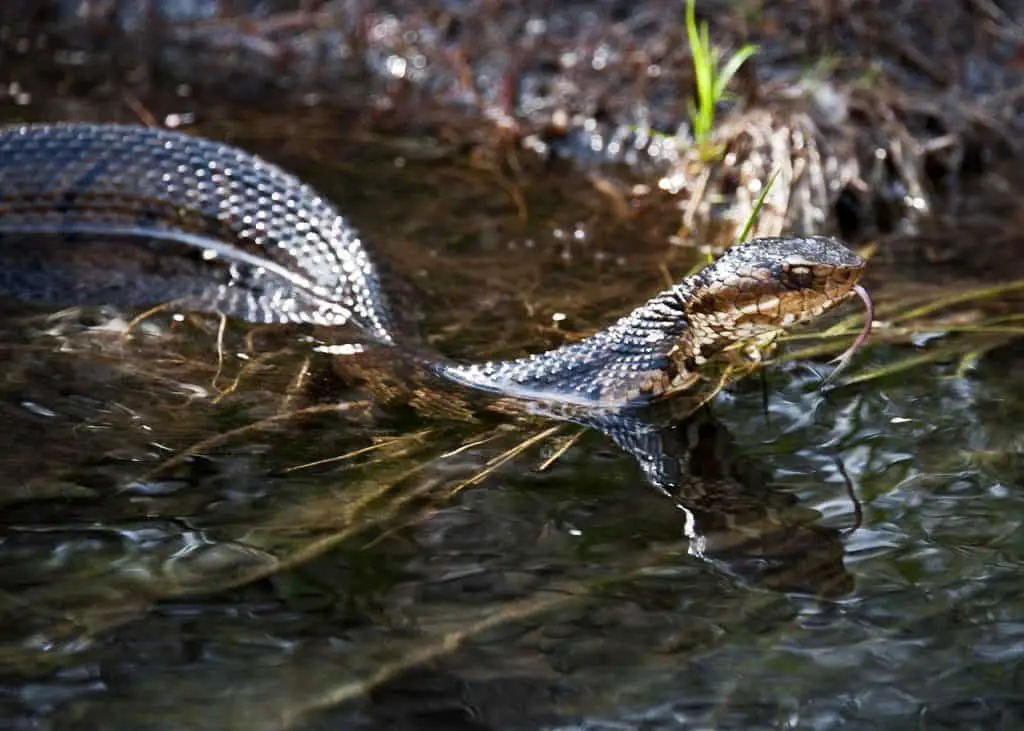
The water moccasin (Agkistrodon piscivorus) is a venomous snake that can often be found in and around lakes. I’ve also heard these snakes called cottonmouths due to the white interior of their mouth. Adult water moccasins can grow up to 2-4 feet (0.6-1.2 meters) in length and have a stocky build. They possess dark, olive-brown or black bodies with a thick, muscular appearance.
Water moccasins are highly adaptable and can inhabit a variety of aquatic habitats, including lakes, swamps, marshes, and slow-moving rivers. They are particularly fond of freshwater environments with abundant vegetation, as these areas attract their primary food source—fish. However, they are capable of surviving in brackish water as well. In lakes, they can often be found along the shorelines, sunning themselves on logs or rocks, or swimming near the water’s edge.
3. Great Blue Heron
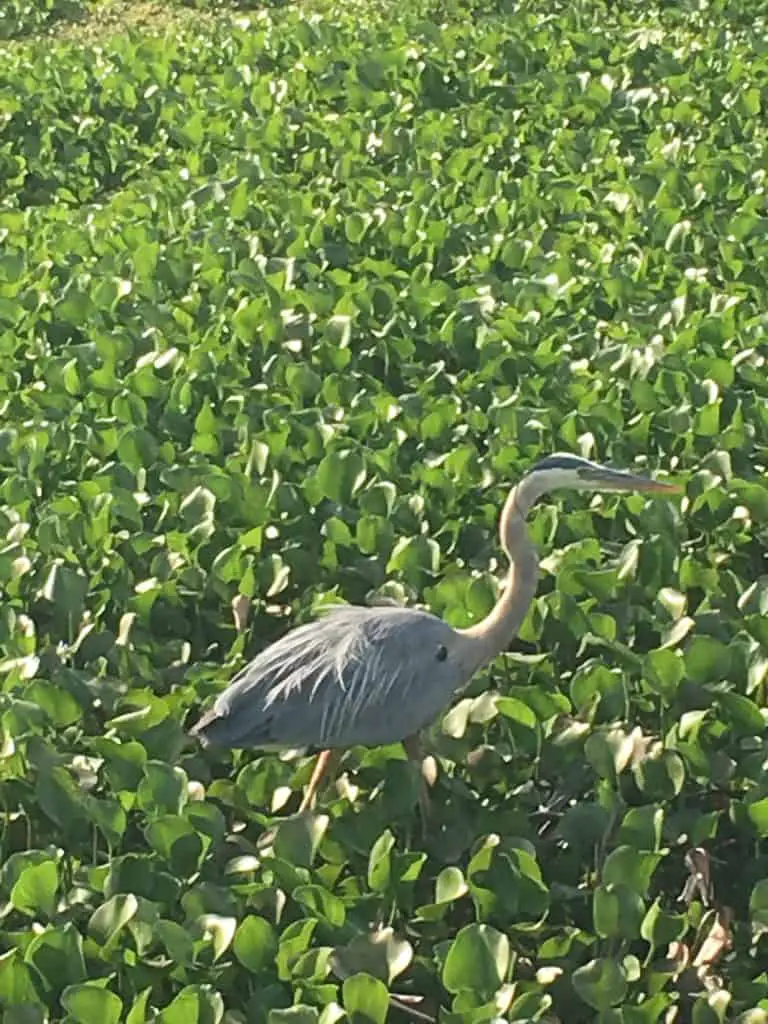
The great blue heron (Ardea herodias) is a magnificent wading bird commonly found in and around lakes. With its distinctive appearance and graceful stature, this species captivates observers. Standing approximately 4 feet (1.2 meters) tall, the great blue heron boasts a long, slender neck, a sturdy, blue-gray body, and a dagger-like bill. Its head is adorned with a black cap and a white face, while its neck and wings showcase subtle tones of blue and purple.
Great blue herons exhibit a versatile habitat preference and can be seen in a range of freshwater environments, including lakes, ponds, marshes, and rivers. They are skilled hunters, using their sharp bills to snatch fish, amphibians, and various aquatic invertebrates from the water. These herons are also known for their patience while they employ stealthy fishing techniques, standing motionless at the water’s edge before striking with lightning speed to catch their prey.
4. Painted Turtle

Painted turtles, scientifically known as Chrysemys picta, are captivating reptiles that possess a distinct appearance that sets them apart from other species. They feature a smooth, olive to black-colored carapace (shell) adorned with colorful patterns of red, orange, and yellow markings, hence their name. The painted turtle’s body is relatively small, measuring around 4-7 inches (10-18 centimeters) in length. Their limbs and head exhibit similar vibrant markings, creating a visually striking ensemble.
Painted turtles display a strong preference for freshwater lakes with abundant vegetation. They also live in ponds, marshes, and slow-moving rivers. These turtles are excellent swimmers and are often spotted basking on rocks or logs along the water’s edge. They are omnivorous, feeding on a diverse diet that includes aquatic plants, insects, small fish, and crustaceans.
5. Flamingo

Flamingos, belonging to the Phoenicopteridae family, are strikingly beautiful birds that inhabit various lakes across the globe. They stand out with their vibrant plumage and unique physical features. With long, slender legs and a distinctive S-shaped neck, flamingos stand tall at around 4-5 feet (1.2-1.5 meters) in height. Their feathers showcase a mesmerizing spectrum of pink, orange, and red hues, which intensify due to their diet rich in carotenoid pigments. Flamingos possess a downward-curving bill that is used to filter-feed on small aquatic organisms, such as algae, shrimp, and mollusks.
Habitat-wise, flamingos prefer saline or alkaline lakes where they can find an abundant food supply. They are often found in large, shallow lakes with mud flats and saline or brackish waters, such as the famous Rift Valley lakes in Africa and the salt pans of South America.
These social birds gather in flocks that can number in the thousands, creating a stunning visual spectacle as they wade through the water, stirring up prey with their feet. But occasionally, you’ll spot a lone flamingo, such as the infamous Pinky I see every winter at St. Marks Wildlife Refuge in North Florida.
6. Frogs

Frogs, belonging to the Anura order, are fascinating amphibians that thrive in various lake ecosystems around the world. These creatures typically have short, stout bodies with long hind legs built for jumping. They possess moist skin that aids in respiration and helps maintain water balance.
Frogs come in an array of colors and patterns, providing camouflage and serving as visual signals. Some species, like the tree frog, feature adhesive toe pads for climbing, while others, like the bullfrog, have a large vocal sac for their distinct calls.
Many species of frogs can be found in lakes with freshwater habitats, residing near the water’s edge, among aquatic vegetation, or in surrounding marshy areas. They are excellent swimmers and rely on lakes for breeding purposes, as they lay their eggs in the water. Frogs play a vital role in lake ecosystems by consuming insects, small invertebrates, and even smaller frogs.
7. Freshwater Mussels
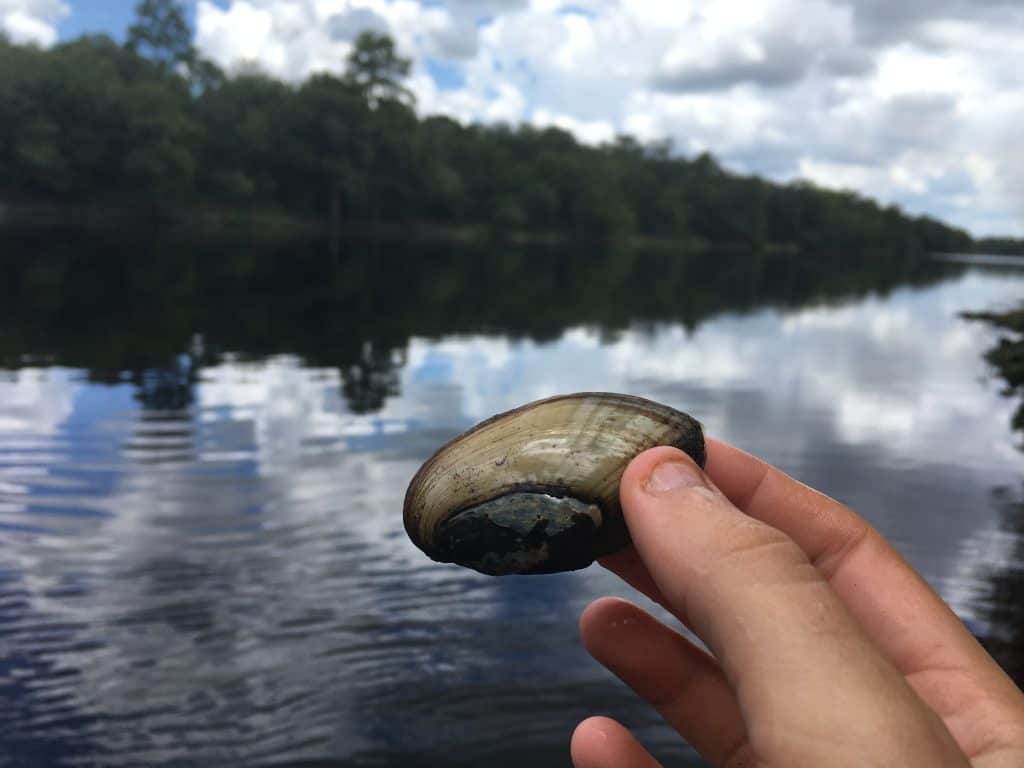
Freshwater mussels, belonging to the Unionidae family, are fascinating filter-feeding organisms that thrive in lakes and various other freshwater habitats. While freshwater mussels can be found around the world, you’ll find the most diversity of species in the Southeastern U.S. In particular, North Florida, Georgia, and Alabama have a wonderfully diverse selection of freshwater mussels, which I had the pleasure of studying as a wildlife biologist for several years.
These mollusks come in a variety of shapes, sizes, and colors, with their shells displaying unique patterns and textures. They have two hinged shells, or valves, that encase their soft bodies, allowing them to close tightly for protection.
Freshwater mussels use a muscular foot to burrow into the sediment at the bottom of lakes, anchoring themselves in place. They play a vital ecological role in maintaining water quality by filtering and purifying the water as they extract nutrients and microscopic organisms.
Freshwater mussels prefer lakes with clean and well-oxygenated water. They inhabit the lakebed, burying themselves partially or completely in the sediment. Mussels often require specific substrates, such as sand or gravel, to facilitate their feeding and reproductive processes. Some of these fascinating creatures rely on fish as part of their life cycle, as their larvae attach to fish gills or fins, utilizing the fish as a means of dispersal.
8. Kingfisher

The kingfisher, a member of the Alcedinidae family, is a remarkable bird that thrives in various lake ecosystems. Kingfishers typically have a stocky build, a large head, and a long, pointed bill ideal for capturing fish. Their feathers exhibit an array of brilliant colors, including shades of blue, green, and orange. With short legs and sharp claws, kingfishers are adept at perching on branches or diving swiftly into the water to seize their prey.
Kingfishers prefer lakes with clear, calm waters that provide optimal visibility for spotting fish. You can often spot these birds near the water’s edge, perched on branches, rocks, or other vantage points, patiently waiting for an opportunity to dive and catch their next meal.
9. Otter

The otter, belonging to the Mustelidae family, is an enchanting and agile mammal that thrives in various lake habitats. These semi-aquatic creatures possess a streamlined body, webbed feet, and a long, muscular tail, all of which make them excellent swimmers. Otters have dense, waterproof fur that helps keep them warm in the water. Their sleek coats vary in color, ranging from dark brown to reddish-brown, with lighter shades on their bellies.
Otters construct dens along lake shorelines, using vegetation, burrows, or abandoned structures. These dens provide a safe refuge for resting, breeding, and raising their young.
10. Ducks

Ducks belong to the Anatidae family. The waterbirds have compact bodies, short necks, and webbed feet, which enable them to swim effortlessly and dive beneath the surface. Their waterproof feathers vary in color and pattern, with vibrant hues adorning their wings and heads.
Male ducks, known as drakes, often display striking plumage and distinctively colored bills, enhancing their visual appeal during courtship displays.
The versatile birds are omnivorous, feeding on a diverse diet that includes aquatic plants, seeds, insects, small fish, and invertebrates. Many duck species build nests on the ground or in vegetation near the water’s edge, providing a safe haven for their eggs and young.
11. Large-mouth Bass
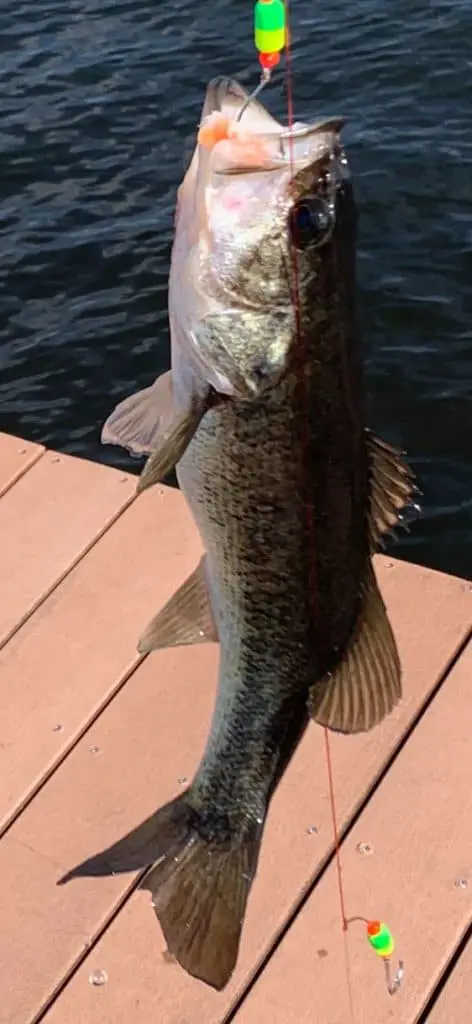
The large-mouth bass (Micropterus salmoides) is a freshwater fish species found in lakes worldwide. These predatory fish are well-known for their impressive size and powerful jaw, which allows them to consume a wide range of prey.
Large-mouth bass have a sleek, elongated body with a distinctive large mouth, giving them their common name. They are typically green or brown in color, often with dark horizontal stripes along their sides. The species can reach considerable lengths, with some individuals exceeding two feet (60 centimeters) in size and weighing over 20 pounds (9 kilograms). Many fishermen pursue these as game fish.
These fish prefer lakes with ample vegetation, submerged structures, and clear or turbid waters. You can find this fish near the lake’s edges, hiding among aquatic plants, fallen logs, or rock formations. The skilled ambush predators often lie in wait for their prey to strike swiftly with their strong jaws. They feed on a diverse diet that includes smaller fish, insects, crustaceans, and even small mammals or birds that may venture close to the water.
12. Catfish
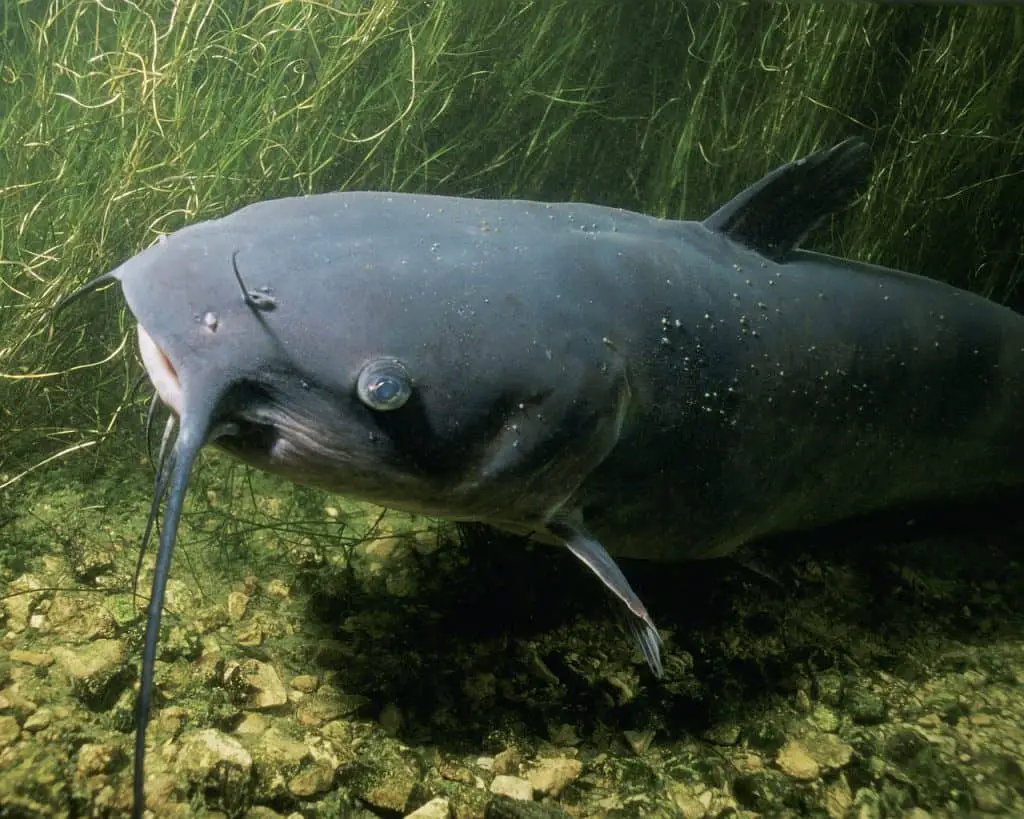
In terms of animals that live in lakes, it’s worth mentioning catfish.
Catfish, belonging to the Siluriformes order, are fascinating freshwater fish that inhabit lakes around the world. The fish possess distinctive barbels, which resemble cat whiskers, and are used for sensory purposes.
Catfish come in a variety of sizes and shapes, with some species sporting smooth skin while others have bony plates known as scutes. They have flattened heads and a downward-facing mouths equipped with sharp teeth.
13. Clams
Clams, belonging to the Bivalvia class, are intriguing aquatic mollusks that inhabit lakes and various other freshwater habitats. These bivalve creatures have two-hinged shells, which provide protection and allow for movement.
Clams have a soft body enclosed within their shells, with a muscular foot used for burrowing and anchoring themselves in the lakebed. They possess a simple, yet efficient, filtration system that enables them to extract food particles from the water.
These creatures often live in lakes with sandy or muddy substrates, where they can bury themselves partially or completely. They prefer calm, shallow areas with slow-moving or still waters. Clams play an essential role in the ecosystem as filter feeders, actively filtering water and removing suspended particles, algae, and organic matter. Their presence contributes to maintaining water clarity and quality.
14. Snails
Snails, belonging to the Gastropoda class, are easy to spot by their spiral-shaped shells, which provide protection and serve as their homes. The soft-bodied creatures have the option to retract into their shells when threatened. They move by gliding on a muscular foot and possess a distinct head with sensory organs and a mouth.
Some snail species have adapted to live on aquatic plants, while others inhabit the lake bottom. Snails are important contributors to lake ecosystems, playing roles in nutrient recycling and serving as a food source for other organisms.
15. Snapping Turtle

The snapping turtle, scientifically known as Chelydra serpentina, is a formidable reptile that thrives in lakes and various freshwater habitats. These turtles have a distinctive appearance, with a large, robust body covered in rough, dark-colored skin. They possess a powerful hooked beak-like mouth and a long, muscular neck, capable of extending quickly to deliver a powerful bite.
Snapping turtles have a spiked tail and sharp claws that aid in their mobility both on land and in water. You can find these turtles in shallow areas near the lake’s edge, basking in the sun or resting on submerged logs. Snapping turtles are opportunistic feeders, consuming a wide range of prey, including fish, amphibians, insects, small mammals, and even carrion.
16. Dragonfly

Dragonflies, belonging to the Odonata order, are mesmerizing insects that inhabit lakes and various aquatic environments. The insects have long, slender bodies with large compound eyes that provide exceptional vision. They possess two pairs of delicate, transparent wings that enable them to maneuver swiftly and gracefully through the air.
Dragonflies commonly spend time near lakes with still or slow-moving waters, especially those with abundant vegetation. You can often find them perching on plants or flying over the water surface, where they hunt for prey. Dragonflies are fierce predators, feeding on a diet of small insects, including mosquitoes and flies, which they catch in mid-air using their long, bristled legs.
17. Swan

Swans, members of the Cygnus genus, are majestic water birds that grace lakes with their elegant presence. The striking birds have large, powerful bodies covered in white feathers, although some species may have patches of black or gray on their wings or head. They have a distinctive, curved neck that allows them to reach underwater vegetation while foraging.
You can often spot swans gliding across the water’s surface, gracefully dipping their heads to feed on aquatic plants and algae. Swans often form lifelong pair bonds, building nests in reed beds or on islands within the lake.
18. Crayfish
Crayfish, fascinating animals that belong to the Astacoidea and Parastacoidea superfamilies, inhabit lakes. These creatures resemble small lobsters, featuring a segmented body and a pair of large pincers called chelae. They display a wide array of colors, ranging from brown and green to vibrant hues of red and blue, which creates a captivating showcase of diversity.
19. Newt
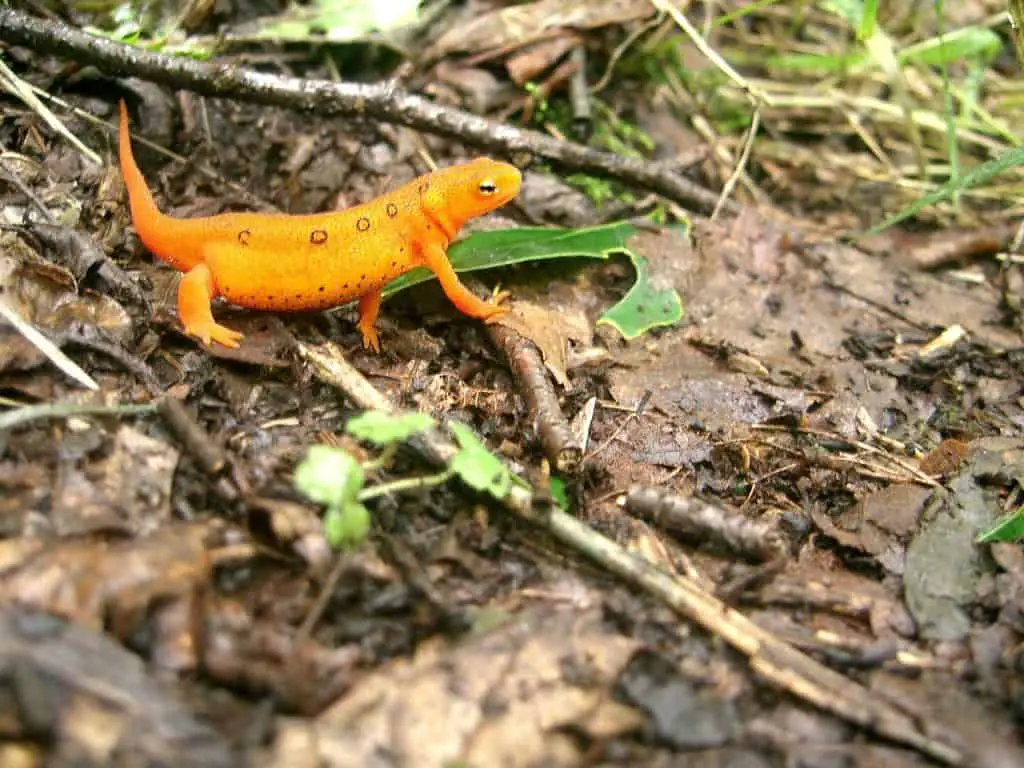
Newts, members of the Salamandridae family, are fascinating amphibians that inhabit lakes and various freshwater habitats. These small creatures are characterized by their slender bodies, smooth skin, and long tails. They typically have bright and vibrant coloration, ranging from orange and yellow to green and black, serving as a warning to potential predators of their toxic skin secretions.
Newts are adept swimmers and can often be observed gliding gracefully through the water. However, they are equally comfortable on land, where they forage for small invertebrates and insects.
20. Loon

Loons, belonging to the Gavia genus, are captivating animals that live in lakes. Loons have sleek bodies, long necks, and striking black and white plumage. They have a distinctive silhouette, with their sharp, pointed beaks and piercing red eyes.
Loons often prefer larger, deep lakes that offer abundant food resources and secluded nesting sites. You can hear their haunting calls, which echo across the tranquil lakeshores during the breeding season.
Frequently Asked Questions
You have questions about animals that live in lakes. We have answers.
What lives in freshwater lakes?
Freshwater lakes are home to a diverse range of organisms. Various fish species, such as bass, trout, and catfish, inhabit lakes and form an essential part of the aquatic food chain. Other inhabitants include waterfowl like ducks and swans, amphibians like frogs and newts, reptiles like turtles and snakes, as well as invertebrates like crayfish and mussels.
What type of animals live in ponds and lakes?
Ponds and lakes support a wide array of wildlife. These include fish, waterfowl, amphibians, insects, mollusks, and aquatic animals. Additionally, plant life such as water lilies and algae play a crucial role in providing habitat and food for the diverse community of animals in ponds and lakes.
What omnivores live in lakes?
Lakes are home to a variety of omnivorous animals that have a diverse diet. One such example is the crayfish, which feeds on both plants and small invertebrates. Ducks, swans, and geese are omnivores because they consume a combination of aquatic plants, insects, and small fish.
Final Take On Animals That Live In Lakes
Animals that live in lakes have unique adaptations to survive the wet conditions. While this list doesn’t include every animal that calls lakes home, it’s a great representation of some of the most interesting lakeside wildlife.
If you are planning a trip to a lake, don’t forget to keep these critters in mind. You never know who you might see!